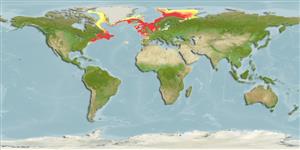Common names from other countries
>
Gadiformes (Cods) >
Lotidae (Hakes and burbots)
Etymology: Brosme: Greek, brosomai, bibrosko = to eat up, to devour (Ref. 45335).
Environment: milieu / climate zone / depth range / distribution range
Écologie
marin démersal; océanodrome (Ref. 51243); profondeur 18 - 1000 m (Ref. 1371), usually 18 - 549 m (Ref. 1371). Temperate; 83°N - 37°N, 75°W - 57°E (Ref. 1371)
Northwest Atlantic: New Jersey to the Strait of Belle Isle and on the Grand Banks of Newfoundland. Rare at the southern tip of Greenland. Northeast Atlantic: off Iceland, in the northern North Sea, and along the coast of Scandinavia to the Murmansk Coast and at Spitzbergen.
Length at first maturity / Taille / Poids / Âge
Maturity: Lm 53.3, range 50 - ? cm
Max length : 120 cm TL mâle / non sexé; (Ref. 9988); common length : 50.0 cm TL mâle / non sexé; (Ref. 1371); poids max. publié: 30.0 kg (Ref. 9988); âge max. reporté: 20 années (Ref. 1371)
Épines dorsales (Total) : 0; Rayons mous dorsaux (Total) : 93 - 103; Rayons mous anaux: 62 - 75; Vertèbres: 64 - 67. Barbel on present on chin, none on snout, its length equal to eye diameter. Color is variable; dorsally dark red-brown or green brown to yellow shading into pale color on belly. Young specimens may have six transverse yellow bands on sides. Vertical fins with dark margin rimmed with white.
Found in small shoals on rough, rock, gravel, or pebble bottoms. Generally keeps far from the shore, near the bottom, mostly between 150 and 450 m in the northeastern Atlantic, and between 18 and 550 m in the northwestern Atlantic. Occurs at a temperature range of 0°-10° C (Ref. 9988). Solitary or in small groups. Feeds on crustaceans and shellfishes, benthic fishes (flatfishes and gurnard) and even on starfishes. Preyed upon by seals (Ref. 9988). Sold fresh, frozen as fillets or dried salted. Eaten steamed, fried, broiled, boiled, microwaved and baked (Ref. 9988).
Spawns in shallower waters between 40-400 m, usually 100 to 200 m. Most important spawning grounds are located between Scotland and Iceland, from 200 to 500 m depth. In the Gulf of Maine, spawning grounds can be found in shallower waters (>50 m). Some individuals even spawn close inshore in Cape Cod, Provincetown Harbor and the Isles of Shoals (Ref. 1371).
Cohen, D.M., T. Inada, T. Iwamoto and N. Scialabba, 1990. FAO species catalogue. Vol. 10. Gadiform fishes of the world (Order Gadiformes). An annotated and illustrated catalogue of cods, hakes, grenadiers and other gadiform fishes known to date. FAO Fish. Synop. 125(10). Rome: FAO. 442 p. (Ref. 1371)
Statut dans la liste rouge de l'IUCN (Ref. 130435)
CITES (Ref. 128078)
Not Evaluated
Menace pour l'homme
Harmless
Utilisations par l'homme
Pêcheries: hautement commercial; pêche sportive: oui
Outils
Articles particuliers
Télécharger en XML
Sources Internet
Estimates based on models
Preferred temperature (Ref.
115969): 0.5 - 7.7, mean 3.6 (based on 726 cells).
Phylogenetic diversity index (Ref.
82804): PD
50 = 1.0000 [Uniqueness, from 0.5 = low to 2.0 = high].
Bayesian length-weight: a=0.00550 (0.00402 - 0.00751), b=3.09 (3.00 - 3.18), in cm Total Length, based on LWR estimates for this species (Ref.
93245).
Niveau trophique (Ref.
69278): 3.9 ±0.3 se; based on diet studies.
Résilience (Ref.
120179): Milieu, temps minimum de doublement de population : 1,4 à 4,4 années (K=0.08-0.16; tm=8-10; tmax=20; Fec=2 million).
Prior r = 0.45, 95% CL = 0.30 - 0.68, Based on 9 full stock assessments.
Fishing Vulnerability (Ref.
59153): High vulnerability (58 of 100).
Climate Vulnerability (Ref.
125649): Moderate vulnerability (44 of 100).
